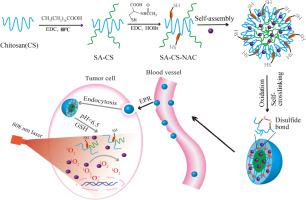International Journal of Biological Macromolecules ( IF 7.7 ) Pub Date : 2020-11-30 , DOI: 10.1016/j.ijbiomac.2020.11.141 Ziming Yang , Puwang Li , Yu Chen , Qiang Gan , Zhipan Feng , Yiguang Jin , Chuang Zhou , Zuyu He , Chao Wang , Yunhao Liu , Changgen Feng

|
A novel pH/glutathione (GSH) multi-responsive chitosan nanoparticles (NPs) material has been successfully designed and prepared by a self-assembly/self-crosslinking method for photodynamic therapy (PDT), which overcomes the shortcomings of traditional photosensitizer carriers, such as poor chemical stability, low loading efficiency and single-responsive photosensitizer release. Amphiphilic sulfhydryl chitosan (SA-CS-NAC) is first prepared by modifying chitosan (CS) with stearic acid (SA) and N-acetyl-L-cysteine (NAC), and then subject to self-assembly and self-crosslinking in the presence of photosensitizer, indocyanine green (ICG), to form the ICG-loaded amphiphilic sulfhydryl chitosan nanoparticles (SA-CS-NAC@ICG NPs). The ICG entrapment efficiency and loading efficiency of the NPs are found to be 95.2% and 27.6%, respectively. The multi-responsive ICG release of the NPs to the low pH and high GSH content of the microenvironment in tumor cells is successfully achieved. Under the laser irradiation, the SA-CS-NAC@ICG NPs produce the amount of reactive oxygen species (ROS) twice of that generated by free ICG under the same conditions. The in vitro cell experiment confirmed the strong cellular uptake ability, low biotoxicity and good tumor inhibition of the NPs. Our work has provided a new strategy for the targeted photosensitizer delivery for PDT.
中文翻译:

通过自组装/自交联方法构建pH /谷胱甘肽响应性壳聚糖纳米粒用于光动力治疗
通过一种自组装/自交联的光动力疗法(PDT)成功地设计和制备了一种新型的pH /谷胱甘肽(GSH)多反应性壳聚糖纳米颗粒(NPs)材料,克服了传统光敏剂载体等缺点。化学稳定性差,负载效率低和单反应型光敏剂释放。首先通过用硬脂酸(SA)和N改性壳聚糖(CS)来制备两亲巯基壳聚糖(SA-CS-NAC)-乙酰基-L-半胱氨酸(NAC),然后在光敏剂吲哚菁绿(ICG)存在下进行自组装和自交联,以形成负载有ICG的两亲性巯基壳聚糖纳米颗粒(SA-CS-NAC @ ICG NP)。发现NP的ICG截留效率和负载效率分别为95.2%和27.6%。成功实现了NPs对肿瘤细胞微环境的低pH和高GSH含量的多响应ICG释放。在激光照射下,SA-CS-NAC @ ICG NP在相同条件下产生的活性氧(ROS)量是游离ICG产生的活性氧量的两倍。在体外细胞实验证实了NPs的强细胞摄取能力,低生物毒性和良好的肿瘤抑制作用。我们的工作为针对PDT的目标光敏剂交付提供了新策略。











































 京公网安备 11010802027423号
京公网安备 11010802027423号